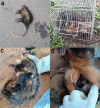Didelphis spp. opossums and their parasites in the Americas: A One Health perspective
- PMID: 33788021
- PMCID: PMC8599228
- DOI: 10.1007/s00436-021-07072-4
Didelphis spp. opossums and their parasites in the Americas: A One Health perspective
Abstract
Medium sized opossums (Didelphis spp.) are among the most fascinating mammals of the Americas, playing important ecological roles (e.g., dispersal of seeds and control of insect populations) in the environment they inhabit. Nevertheless, as synanthropic animals, they are well adapted to human dwellings, occupying shelters within the cities, peripheral areas, and rural settings. These marsupials can harbor numerous pathogens, which may affect people, pets, and livestock. Among those, some protozoa (e.g., Leishmania infantum, Trypanosoma cruzi, Toxoplasma gondii), helminths (e.g., Ancylostoma caninum, Trichinella spiralis, Alaria marcianae, Paragonimus spp.) and arthropods (e.g., ticks, fleas) present substantial public health and veterinary importance, due to their capacity to cause disease in humans, domestic animals, and wildlife. Here, we reviewed the role played by opossums on the spreading of zoonotic parasites, vectors, and vector-borne pathogens, highlighting the risks of pathogens transmission due to the direct and indirect interaction of humans and domestic animals with Didelphis spp. in the Americas.
Keywords: Didelphis spp.; Public health; Reservoirs; Vectors; Wildlife; Zoonotic parasites.
© 2021. The Author(s).
Figures



References
-
- Abramowicz KF, Wekesa JW, Nwadike CN, Zambrano ML, Karpathy SE, Cecil D, Burns J, Hu R, Eremeeva ME. Rickettsia felis in cat fleas, Ctenocephalides felis parasitizing opossums, San Bernardino County, California. Med Vet Entomol. 2012;26:458–462. doi: 10.1111/j.1365-2915.2012.01017.x. - DOI - PMC - PubMed
Publication types
MeSH terms
LinkOut - more resources
Full Text Sources
Other Literature Sources
Miscellaneous

